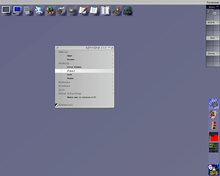 Screenshot of an AfterStep desktop. | |
| Stable release | |
|---|---|
| Repository | |
| Written in | C |
| Operating system | Unix-like |
| Type | Window manager |
| License | 2.x: MIT[3] 1.x: GPL-2.0-or-later[4] |
| Website | www.afterstep.org |
AfterStep is a stacking window manager for the X Window System. The goal of AfterStep's development is to provide for flexibility of desktop configuration, improved aesthetics and efficient use of system resources, and was used in such distributions as MachTen. AfterStep originally was a variant of FVWM modified to resemble NeXTSTEP, but as the development cycle progressed, it diverged from its FVWM roots. In 2000, Linux website TuxRadar selected AfterStep as one of the year's best window managers, praising it as "fast and reliable, with a huge range of configuration options and the ability to create some spectacular themes".[5]
YouTube Encyclopedic
-
1/3Views:32513 605249 081
-
TUMBLED ROCKS AFTER STEP ONE AND TWO
-
Eyebrows eyeliner tattoo Semi & Permanent Makeup: Before and After Step by Step
-
USMLE - Everything You Need To Know in 2022 | From USMLE Step 1 To Residency
Transcription
Features
Features of the AfterStep window manager include:
- Stacking windows
- Written in C
- Window decorations include borders and titlebars
- Titlebars have buttons for menu, minimize, maximize and close
- Active applications can be displayed in a taskbar via the winlist module
- Uses the GTK+ toolkit
- Support for modules
- Support for multiple desktops
- Desktop switching via a pager module
- Dependent on Perl and ImageMagick
Modules
AfterStep includes several modules such as:
- Pager - a visual tool for managing and cycling between multiple desktops
- WinList - a simple Taskbar displaying active applications
- Wharf - docking tool that manages Applets/Dockapps and launches application.
AfterStep also supports virtual screens, and relies on a set of text-based configuration files for customizing its appearance.
AfterStep is maintained by a small community of developers with Sasha Vasko serving as project manager.
See also
References
- ^ "Changelog". 1 April 2013. Retrieved 24 December 2015.
- ^ "Release 2.2.12". 14 May 2013.
- ^ "afterstep/COPYRIGHT". GitHub. 30 November 2004.
- ^ "afterstep/COPYRIGHT.OLD". GitHub. 30 November 2004.
- ^ "From the archives: the best window managers of 2000 | TuxRadar". www.tuxradar.com. Archived from the original on 2009-03-13.
External links
- Official website
- "AfterStep". Freecode.
- AfterWiki Main Page
- AfterStep Applets
- Window Manager for X: AfterStep
- Rob's AfterStep Page
- AfterStep 1.3.1 article by Guylhem Aznar in Linux Journal
